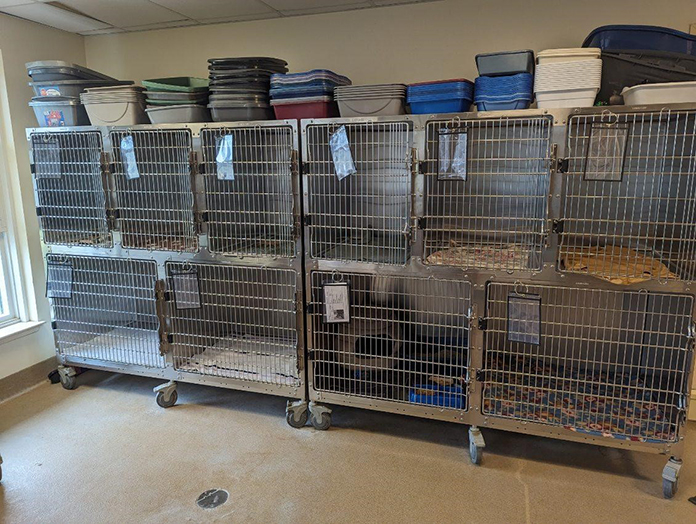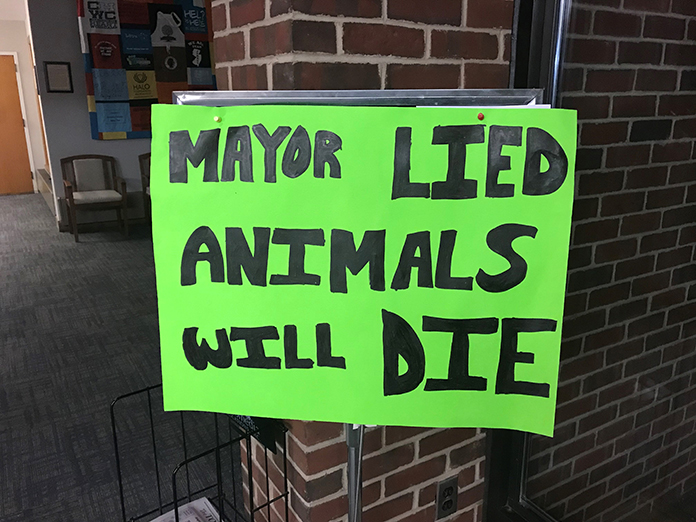
TOMS RIVER – While the Toms River Animal Shelter is not technically closing, it just might not be Toms River employees taking care of the animals in the future.
A series of decisions have made people worried about the future of the shelter and the safety of the animals. The most recent move is that the town posted a contract online looking for bidders for animal control companies. Residents have seen this as the writing on the wall that the facility will close, and that a third party company will take over for the duties of taking unwanted animals and bringing them directly to the county.
The request for services is as follows: “The Township is seeking an experienced company to provide the below services, not exclusive to: impoundment of domestic animals, rabies quarantine, stray cat removal, dogs running at large, stray dogs, abandoned animals, vicious/dangerous dogs, transportation of domestic animals to a designated holding facility, dead wildlife on township property, capture and removal of sick or injured wildlife, provision of animal cruelty investigations, provision of monthly reports of all services provided, enforcement of all township ordinances, inclusive or attendance at judicial proceedings, when required.”
Currently, township employees do this work.
Mayor Daniel Rodrick has also ordered that the shelter employees ship all new animals to the county shelter instead. Employees were ordered not to tell the public that this was being done, a source said. Therefore, if someone in Toms River is looking for their runaway pet, they might not know to look for them in Jackson.

The county has received 19 animals from Toms River in 2024, according to their figures. This number includes animals previous to January 12, when the mayor made this decree.
On one hand, people say that the county shelter has a higher kill rate than the town’s. On the other hand, people argue that the rate is higher because the county winds up being the last on a series of stops for aggressive or sick animals. The argument there is that the county is given the animals that can’t be adopted, so they get euthanized.
The bid for animal services, Rodrick said, would be in case the county took over.
There was a protest before the most recent Township Council meeting organized by the NJ Animal Save Movement. During the meeting, large screens showed pets that have been recently adopted from the shelter.
During the public portion of the meeting, residents spoke out against Rodrick’s new policies. Several residents asked the mayor and council to build on the successes of the shelter rather than attack it.
Resident Michael Cohen shared that he volunteered at the shelter before taking on a part time job there. The only paid staff are two animal control officers and two part timers.
He read off statistics comparing the euthanasia rates of Toms River versus the county. Toms River’s kill rate was 6.15 for 2023. The county’s was 21.37.
“If anybody thinks that dogs and cats are going to be safer in the Ocean County shelter, you might want to look at statistics,” he said. He further explained that Toms River takes in wildlife, such as the snake that got brought in that morning. They’ve had swans and guinea pigs. “Anything like that would have nowhere to go if the county took us over.”
“There’s never been a plan to close the shelter,” Rodrick told a crowd of people at the meeting, several of whom were at the protest. “There has been talks with the county to run it” during the previous and current administration.
He indicated that there has been a large donation that will run the shelter for the next two years.
Resident Dennis Galante said the problems of the past have all been solved, and noted a $1 million donation from a woman who recently passed away. If it goes to the county, what happens to the donations?
Rodrick said they would be required to keep the animals in order to continue with the donation.
“I feel it was not very well run,” Rodrick said of the shelter at one point in the meeting.
Resident Julie Adamek said the shelter has been “grossly understaffed.” Despite that, and contrary to the mayor’s description, the shelter is very clean and the animals are well cared for. “The employees they have there are very dedicated. It’s disheartening to hear them and the shelter be insulted,” she said. It’s not the shelter workers that haven’t given the animals what they need, it’s the town itself.

Residents shared stories of how these animals come to the shelter to begin with. In some cases, people come down for the summer, adopt a pet for a few months, and then leave it behind. Also, people are losing their homes and can’t take their pets with them.
Previously, Rodrick changed the hours of the shelter, making them open later so that people would be able to come after work to adopt. He also took away the requirement of needing to make an appointment. He said these two things hindered people from adopting.
Recently, all fees were to be waived, so that the animals would be given out for free. Animal supporters were worried that this will attract hoarders and other people who don’t have the animals’ best interests in mind. For example, there was a suspected dog fighting operation recently busted in Howell.
After more than a month of no more animals being brought in, and aggressive measures to place animals with adopters, there are far fewer animals in the shelter.
As Rodrick said to one resident “The intent was never to shut the shelter down. The conversations with the county are ongoing.” Whether the county runs it or the township, “I don’t understand how that would be different.”






